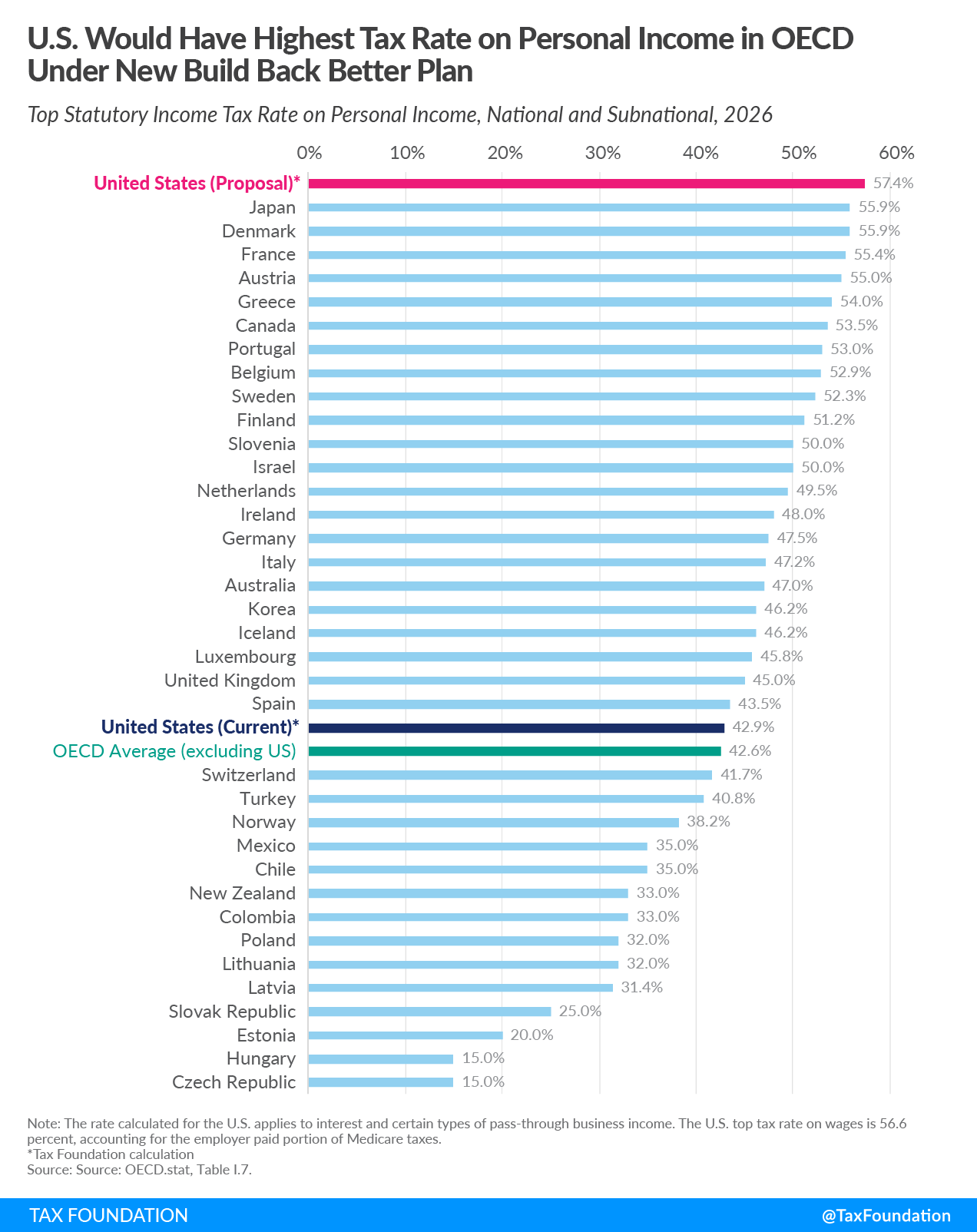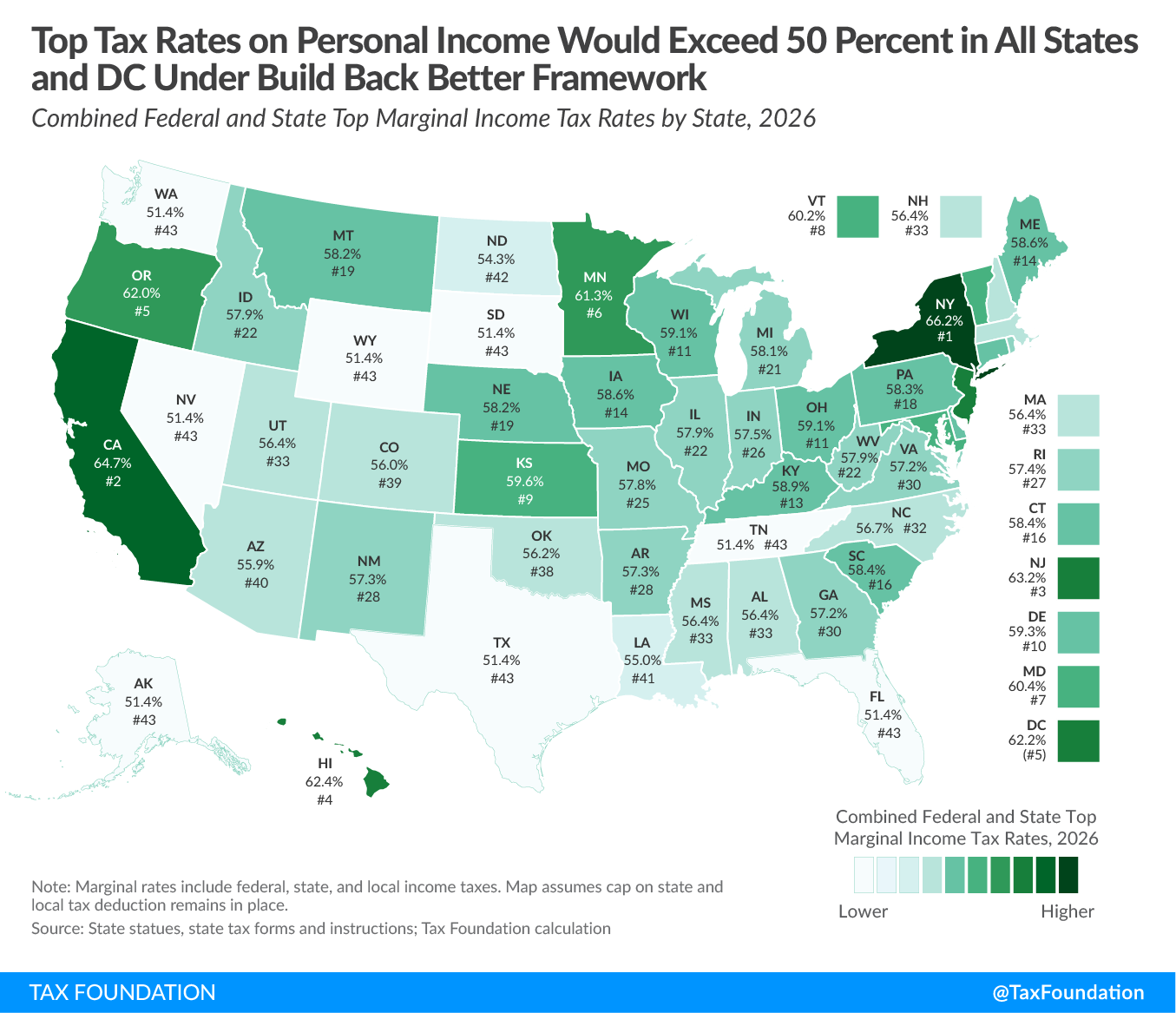Under the latest iteration of the House Build Back Better Act (BBBA), the average top taxA tax is a mandatory payment or charge collected by local, state, and national governments from individuals or businesses to cover the costs of general government services, goods, and activities. rate on personal income would reach 57.4 percent, giving the U.S. the highest rate in the Organisation for Economic Co-operation and Development (OECD). All 50 states plus the District of Columbia would have top tax rates on personal income exceeding 50 percent.
High-income taxpayers would face a surcharge on modified adjusted gross incomeFor individuals, gross income is the total of all income received from any source before taxes or deductions. It includes wages, salaries, tips, interest, dividends, capital gains, rental income, alimony, pensions, and other forms of income. For businesses, gross income (or gross profit) is the sum of total receipts or sales minus the cost of goods sold (COGS)—the direct costs of producing goods, including inventory and certain labor costs. (MAGI), defined as adjusted gross income less investment interest expense. The surcharge would equal 5 percent on MAGI in excess of $10 million plus 3 percent on MAGI above $25 million, for a total surcharge of 8 percent. The plan would also redefine the tax base to which the 3.8 percent net investment income tax (NIIT) applies to include the “active” part of pass-through income—all taxable incomeTaxable income is the amount of income subject to tax, after deductions and exemptions. Taxable income differs from—and is less than—gross income. above $400,000 (single filer) or $500,000 (joint filer) would be subject to tax of 3.8 percent due to the combination of NIIT and Medicare taxes. Under current law, the top marginal tax rate on ordinary income is scheduled to increase from 37 percent to 39.6 percent starting in 2026. Overall, the top marginal tax rateThe marginal tax rate is the amount of additional tax paid for every additional dollar earned as income. The average tax rate is the total tax paid divided by total income earned. A 10 percent marginal tax rate means that 10 cents of every next dollar earned would be taken as tax. on personal income at the federal level would rise to 51.4 percent.
In addition to the top federal rate, individuals face taxes on personal income in most U.S. states. Considering the average top marginal state-local tax rate of 6.0 percent, the combined top tax rate on personal income would be 57.4 percent—higher than currently levied in any developed country. This assumes the deduction for state and local taxes remains capped. If we assume the cap for the state and local tax deduction is lifted, the average top marginal state-local tax rate would fall to 54 percent.
Eight states plus the District of Colombia would face top tax rates higher than 60 percent. Taxpayers in New York and California would face the highest tax rates, at 66.2 percent and 64.7 percent respectively. Even in the eight states that forgo an income tax, such as Florida and Nevada, taxpayers would have a top rate of 51.4 percent, which far exceeds the top rates found in most OECD countries.
As policymakers explore options to raise revenue, they should keep in mind how the U.S. compares to other countries and what the economic effects might be. Raising the top marginal tax rate on ordinary income to the highest in the OECD will damage U.S. competitiveness. It will also reduce incentives to work, save, invest, and innovate, with broad implications for the U.S. economy.
Note: This post was originally published on October 22nd, but has been updated on November 1st to reflect the recent proposals in the Build Back Better framework.
Launch Resource Center: President Biden’s Tax Proposals

